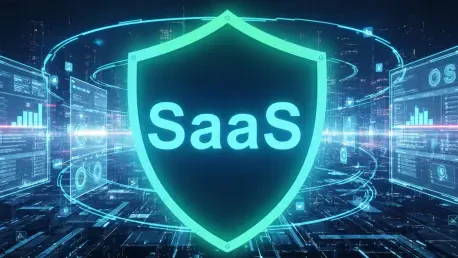In today’s fast-evolving digital landscape, businesses rely on an intricate web of Software-as-a-Service (SaaS) applications—often exceeding 100 per organization—to power everything from customer relationship management to internal communications, yet this dependency exposes critical data to vulnerabilities. With risks like cyberattacks, accidental deletions, or service outages leaving sensitive information unprotected, innovative solutions are becoming essential. This report delves into how Keepit, a leading player in SaaS data protection, is harnessing artificial intelligence (AI) to revolutionize backup strategies and expand its reach across hundreds of applications, setting a new standard for security in the industry.
The Growing Importance of SaaS Data Protection
Industry Overview and Current Landscape
The SaaS ecosystem has become the backbone of modern business operations, enabling seamless collaboration and scalability for organizations of all sizes. With many enterprises managing a sprawling portfolio of apps, the volume of critical data—ranging from customer records to financial details—stored in these platforms is staggering. However, the lack of inherent backup mechanisms in many SaaS solutions poses a significant risk, making third-party protection providers indispensable.
Key players like Keepit, HYCU, and Druva have emerged as vital allies in this space, offering specialized services to secure data against loss or breaches. Keepit stands out by operating its own data centers, avoiding reliance on public cloud giants like AWS or Azure, which provides an added layer of control over data security. This independence, coupled with a focus on safeguarding sensitive information, positions the company as a trusted partner for businesses navigating the SaaS terrain.
The current landscape reveals a pressing need for robust data protection as regulatory requirements tighten and cyber threats grow more sophisticated. Companies cannot afford downtime or data loss, especially when customer trust is at stake. This dynamic has fueled demand for comprehensive backup solutions that can keep pace with the ever-expanding array of SaaS tools in use today.
Technological and Market Influences
The rapid adoption of SaaS platforms across industries has created a parallel surge in the need for reliable backup and recovery systems. As businesses integrate more applications into their workflows, the complexity of managing and protecting data multiplies, pushing providers to innovate at an accelerated rate. This trend shows no signs of slowing, with market projections indicating continued growth in SaaS usage over the coming years.
Emerging technologies, particularly AI, are reshaping data protection strategies by automating processes that were once labor-intensive. AI’s ability to analyze patterns, predict vulnerabilities, and streamline operations is giving companies like Keepit a competitive edge. Beyond technology, market forces such as customer expectations for seamless integration and heightened security are driving providers to adapt quickly to diverse needs.
Economic factors also play a role, as organizations seek cost-effective solutions that deliver value without compromising on safety. The intersection of technological advancements and market demands is creating a fertile ground for innovation, with AI at the forefront of transforming how SaaS data is secured and managed in a highly competitive environment.
Keepit’s Innovative AI-Powered Strategy
Expanding SaaS App Coverage with AI Tools
Keepit is setting ambitious goals to protect hundreds of SaaS applications by 2028, leveraging AI-driven tools to accelerate its expansion. Central to this strategy is a Domain-Specific Language (DSL) framework that simplifies the development of connectors—specialized code that links Keepit’s backup software to the APIs of various SaaS platforms. This approach allows for faster and more efficient integration with a wide range of apps.
A standout feature of Keepit’s methodology is the use of an internal AI tool designed to revolutionize workload API discovery. Traditionally, mapping an app’s API environment could take days or even weeks when done manually. With AI, Keepit can complete this process in as little as an hour, slashing development timelines and enabling rapid scaling of its protection capabilities.
Additionally, AI assists in the code-writing phase within the DSL framework, further streamlining connector creation. This dual application of AI not only boosts efficiency but also ensures that Keepit can keep up with the growing number of SaaS apps in the market. The result is a dynamic, forward-thinking approach that promises to cover an extensive app portfolio in record time.
Prioritizing Customer Needs and App Selection
A cornerstone of Keepit’s expansion strategy is its commitment to a user-driven model, where customer feedback directly influences which apps receive priority for protection. Through a dedicated section on its website, the company gathers input from users to identify high-demand platforms, ensuring that its development efforts align with real-world needs. This approach fosters a strong connection with its client base.
Currently protecting a growing number of apps, Keepit has outlined plans to include popular tools like Confluence, Jira, and Okta in its coverage within the next one to two years. Looking further ahead, potential support for platforms such as ChatGPT, Slack, and HubSpot is under consideration, contingent on market demand and user requests. This adaptability underscores Keepit’s focus on relevance and responsiveness.
By maintaining an open dialogue with customers, Keepit ensures that its resources are allocated effectively, targeting applications that matter most to businesses. This strategy not only enhances user satisfaction but also positions the company as a flexible and customer-centric leader in the SaaS protection arena, ready to pivot based on evolving priorities.
Challenges in Scaling SaaS Protection
Scaling connector production to meet ambitious targets presents a host of challenges for Keepit, particularly given the intricate nature of API integration. Traditional methods of API discovery are notoriously time-intensive, often requiring extensive manual effort to understand and map out the data access points of each SaaS platform. This bottleneck can slow down even the most determined expansion plans.
Beyond discovery, integrating with diverse SaaS environments introduces additional complexities, as each app may have unique security protocols, data structures, and update cycles. Maintaining consistent performance across an expanding portfolio of apps adds another layer of difficulty, as discrepancies in functionality or reliability could undermine user trust. These hurdles require careful navigation to avoid delays or quality issues.
To address these obstacles, Keepit is leaning heavily on AI automation to expedite processes and enhance precision in connector development. By reducing human intervention in repetitive tasks and proactively identifying integration challenges, the company aims to ensure scalability without sacrificing standards. This strategic use of technology is pivotal in overcoming the inherent difficulties of rapid growth in a fragmented SaaS landscape.
Enhancing User Experience with AI Integration
Keepit is poised to elevate the user experience through the introduction of a Model Context Protocol (MCP) interface, currently in preview mode. This innovative feature enables seamless interaction with external Large Language Models (LLMs) like ChatGPT, allowing customers to query their backup systems using natural language. Such accessibility marks a significant leap in simplifying complex data protection tasks.
With MCP, users can ask specific questions—such as the status of backups for a particular app—and receive detailed insights into backup health, audit logs, and even anomaly detection. This capability empowers businesses to gain a deeper understanding of their data protection posture without needing technical expertise, making the process more intuitive and efficient.
The integration of AI-driven natural language processing offers substantial benefits for organizations seeking rapid analysis of their SaaS backup status. By breaking down barriers to information access, Keepit is enhancing transparency and control for its customers, ensuring they can manage risks effectively. This user-friendly advancement reflects a broader trend of leveraging AI to make sophisticated systems more approachable for everyday use.
Future Horizons for SaaS Data Protection
Long-Term Data Preservation Strategies
Looking toward sustainable data management, Keepit is exploring solutions for preserving cold data—information like old SharePoint or Salesforce records that are rarely accessed but hold potential value. One option under consideration is offline tape storage, which could provide a secure, cost-effective method for archiving such data. A possible rollout for this initiative is slated within the next year or two.
Even though access rates for archived data may be low, its importance for AI-driven analysis cannot be understated. Historical records can offer critical insights for predictive modeling or compliance purposes, making preservation a strategic priority. Keepit’s forward-thinking approach ensures that businesses can retain valuable information without burdening active systems.
This focus on long-term storage solutions highlights a comprehensive vision for data lifecycle management. By addressing the needs of both active and dormant data, Keepit is positioning itself as a partner for the full spectrum of data protection challenges, anticipating future demands in an era where information is a key asset for innovation.
Emerging Trends and Market Opportunities
The SaaS protection sector is witnessing a transformative shift, with AI increasingly central to solving intricate challenges and enhancing user engagement. From automating connector development to enabling natural language interactions, AI is redefining how providers deliver value, creating opportunities for differentiation in a crowded market. This trend is expected to intensify as technology continues to evolve.
Customer preferences are also shifting, with a growing emphasis on seamless integration, real-time insights, and cost efficiency. These evolving demands are opening new growth areas for SaaS backup providers, particularly those that can adapt swiftly to emerging needs. Potential disruptors, such as novel AI applications or alternative storage models, could further reshape the competitive landscape.
Keepit is well-placed to capitalize on these opportunities, thanks to its proactive adoption of cutting-edge tools and customer-centric policies. As reliance on SaaS platforms deepens, the market for robust protection solutions will expand, offering fertile ground for innovation. Companies that balance technological prowess with responsiveness to user needs are likely to lead the charge in this dynamic space.
Conclusion: Keepit’s Vision for a Secure SaaS Future
Reflecting on the insights gathered, Keepit has carved a distinctive path in the SaaS data protection realm by harnessing AI to tackle critical gaps through automated connector development and intuitive user interfaces. The journey showcases a deliberate balance between addressing immediate customer priorities and laying the groundwork for scalable growth. As a next step, businesses and stakeholders should consider investing in AI-enhanced backup solutions to stay ahead of evolving risks, ensuring resilience in a SaaS-dominated landscape.
Moreover, Keepit’s exploration of long-term data preservation signals a readiness to adapt to future challenges, urging industry players to think beyond short-term fixes and embrace holistic data strategies. A key takeaway is the potential for collaborative innovation—partnering with customers to prioritize app coverage could set a benchmark for others. Moving forward, fostering such synergies and accelerating AI integration will be crucial to fortify data security and unlock untapped value in archived information.









